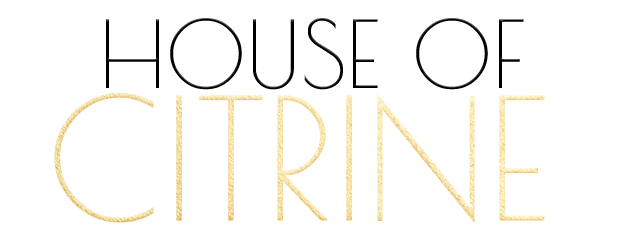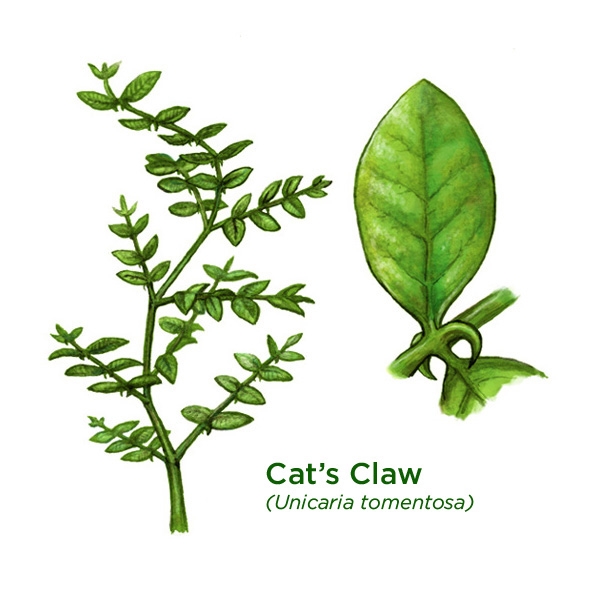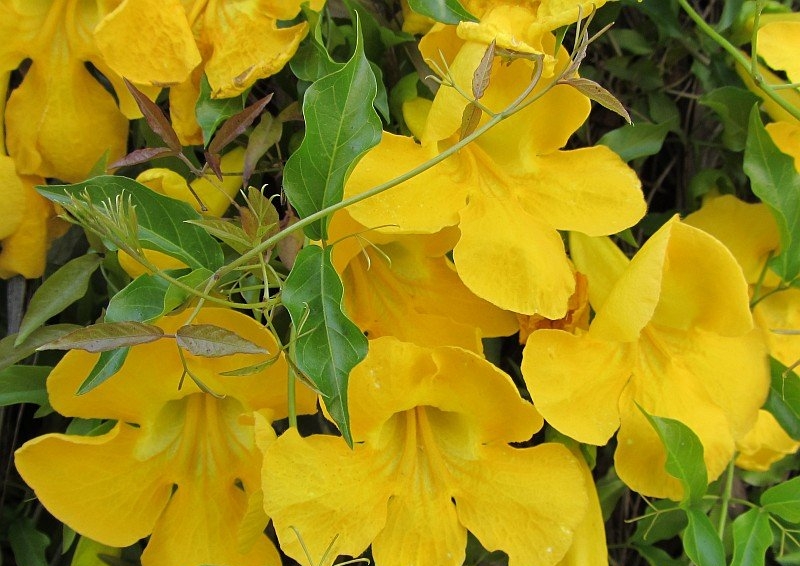By: Molly Helfend
Sacred herb of the Rain Forest. Life-giving vine of Peru. Uña de gato. These are all names used to describe the medicinal tropical vine known in western cultures as Cat's Claw. A member of the Rubiaceae family, Cat's Claw is a sacred plant traditionally used in Peruvian cultural medicine and more recently introduced into western herbalists’ armamentarium. Not much research has been done on this herb, but what has been found is astronomical. “Research has shown the plant contains immune stimulating alkaloids, which also enhance the parasympathetic nervous system” (Horne, 2010).
In simpler terms, it is an immune stimulating powerhouse that been proven to help eliminate free radicals that cause cellular damage. It curatively inhibits cancer growth and improves DNA repair. Some say, it works better than medicinal mushrooms! It is also used to relieve chronic pain and fantastic for curing intestinal inflammation and disorders. Because of its immunity enhancing properties, it is one of the “most sacred [herbs] among the Ashaninkas, Campo and other Amazonian tribes. According to indigenous Shamans, uña de gato serves as a bridge and balancer between the physical and spiritual worlds, which is helpful to health problems since they believe in spiritual causes of bad health” (Draxe, 2016). There is a certain supernatural ability and consciousness when ingesting this herb. What is also interesting, is that Cat's Claw looses its medicinal potency when absorbed directly through the tongue. Washing a tincture down with water or any other preparation with lemon juice or apple cider vinegar is key to allowing the magic to permeate into the jungle of your soma and soul.
Phytochemistry: Alkaloids, glycosides, procyanidins, saponins.
Herbal Actions: Adaptogenic, anti-microbial, anti-viral, anti-inflammatory, anti-tumor, antimutagenic immunostimulant,
How to Prepare: Tincture, tea, capsule, liquid extract, cream
What to Use For: Rheumatism, arthritis, inflammatory problems. cancerous cell formation, gastric ulcers, stomach and bowel disorders, colitis, Crohn's disease, irritable bowel syndrome, leaky gut and bowel syndrome, gastritis, viral and fungal infections, Herpes, Candida.
Growing Conditions: Cultivated in Brazil, Peru and other Amazonian regions of South America, it requires more shade, which is why it is primarily managed in tropical rainforests. The trees themselves are typically 100 feet or higher.
Harvesting Methods: Because of the destructiveness to the tree organism, the root is not as commonly harvested. However, the inner bark is inexpensive and common amongst trade producers. Please leave the harvesting to the local indigenous farmers of South America. It is best to buy Cat's Claw from a local apothecary or sustainable and trusted fair-trade supplier.
Parts of Plant Used: Inner bark and root
Precautions: Very few side effects, but some people reported dizziness, nausea and diarrhea when taken in large amounts.
This information is not a replacement for a medical professional, so please consult before treating yourself or others with this or any other herbal remedy
A personal reinvention of Sunfood’s Superherb Bomb, this is my potent, immune stimulating and awakening “super herb” hot chocolate creation. The ingredients synergistically create a non-guilty dessert-like treat to savor, heal and nourish the body.
Molly’s “Superherb" Savory Chocolate Delight
1 cup Yerba Mate
2 tbs Cacao Powder
1 tbs Tocos
1 tbs Cat’s Claw
1 tbs Tigernuts
1 tbs Maca
1 tsp Chrawnaprash
1 tsp Vanilla Powder
Splash of Raw Coconut Milk
*Optional* - Dash of Peppermint Essential Oil
Steep 1 cup of Yerba Mate in boiling water for suggested time. If Cat's Claw is in dried bulk form, steep in 1 cup of boiling water for about 10 to 15 minutes. (If it is in tincture or liquid extract, please put suggested amount directly into the blender). Once ready, pour both steeped teas into the blender with the cacao powder, tocos, tigernuts, maca, chrawnaprash and vanilla powder. Blend until smooth. Pour into mug or glass jar and add a splash of coconut milk. Enjoy!
Molly Helfend is part of the HOC team and is a writer, ethnobotanist, herbalist and environmental activist. She graduated from University of Vermont in 2016 with a Bachelor of Science in Environmental Studies and a concentration in Holistic Health and recently from University of Kent in 2018 in Canterbury, England with a Masters of Science Degree in Ethnobotany. She has worked for Urban Moonshine, Greenpeace and received her herbalism training with Spoonful Herbals. Her goal is to travel the world, researching plant-human interconnected relationships while continuing to educate about the transformational energy of life. Molly resides in Raglan, New Zealand, working as an herbalist at the Herbal Dispensary.










